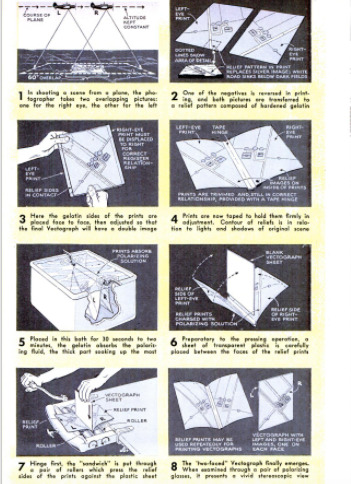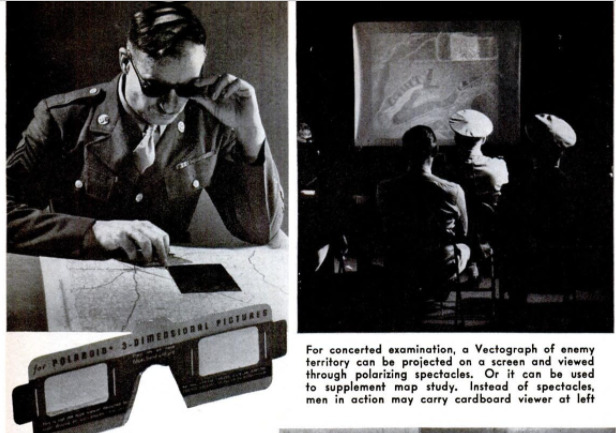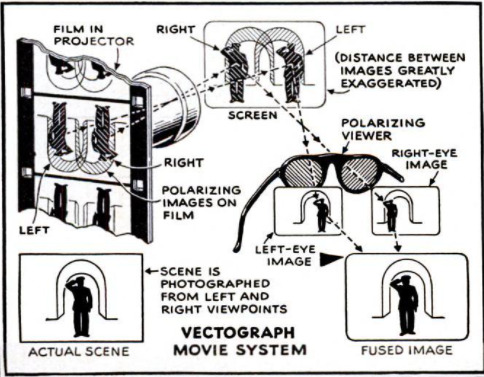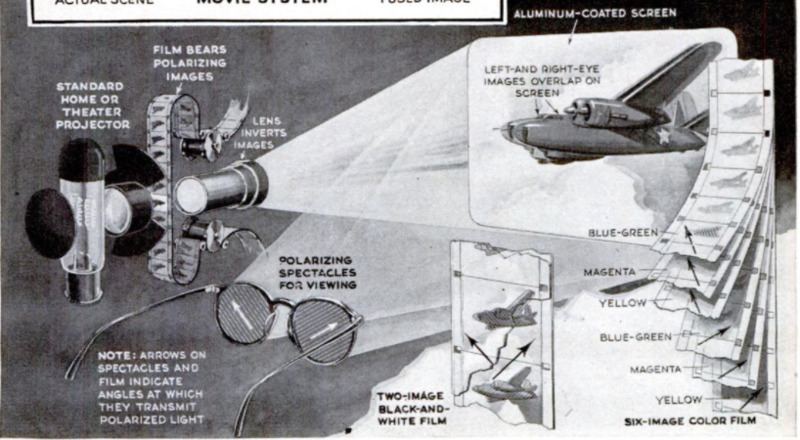-
Title (Dublin Core)
-
Polarized light for the eyes of the army
-
Article Title and/or Image Caption (Dublin Core)
-
Title: Polarized light for the eyes of the army
-
Subtitle: New aerial pictures show enemy territory in three dimensions
-
extracted text (Extract Text)
-
ENROLLED in classes at a Cambridge,
Mass., laboratory, picked men of the
Army, Navy, and Marine Corps are
learning a new way to make aerial photo-
graphs possessing depth, or a third dimen-
sion. The pictures clearly reveal bomb dam-
age to industrial plants. They pierce such
camouflage as false shadows and make-be-
lieve “gardens” painted on roofs of war
factories. Vividly they show the contours
of shore lines, cliffs, hills, and valleys in
enemy-held territory. Trees, ditches, and
bushes, important in providing cover, appear
in full relief like an exact-scale model.
From brief study of such a picture, too,
a military strategist may deduce the loca-
tions of hostile strong points, and
how they may be taken by a sur-
prise raid, or reduced in a full-dress
invasion. By projecting the pictures
on a screen, a leader may instruct
his men exactly in the individual
parts they are to play. Finally, since
an unlimited number of duplicates of
a picture may be made, every man
going into action may carry his per-
sonal copy, together with a simple
card viewer for examining it—in a
fox hole, aboard an assault boat, or
even inside a tank.
The same process, with little or no
modification, offers fascinating fu-
ture possibilities to amateur and pro-
fessional photographers. Still and
motion pictures, both in black-and-
white and in color, will be endowed
with the final realism of depth. The
stills may be mounted in albums, or
finished as transparencies. Tridimen-
sional color movies, long the dream
of inventors, will assume such prac-
tical form that they may be exhib-
ited with standard home and theater
projectors. All these innovations
have been perfected. Their introduc-
tion to the public awaits only peace.
Until then, the entire production of
the Polaroid Corporation, maker of
the materials, is filing U.S. war
needs.
Military classes produce the relief
photographs, called Vectographs, in
their first day of instruction. Simplicity of
the procedure contrasts with the remarkable
combination of optical and chemical princi-
ples underlying it. Credit for the process
goes to a research team directed by Edwin
H. Land, the same brilliant young inventor
whose Polaroid, the first practical light-
polarizing material, startled the scientific
world some years ago (P.S.M., April '36,
p. 20). Vectographs also use polarized, or
“one-way,” light, vibrating in only one
plane, but produce it in a new way. Watch-
ing a Vectograph made helps to make the
idea clear.
Raw material consists of a pair of stereo-
scopic, or left-and-right-eye, negatives
‘which may be made with the simplest of box
cameras by shifting the camera between
two successive exposures. For stopping mo-
tion, professionals use a more expensive
camera with twin lenses and synchronized
shutters. In the air, a pair of overlapping
pictures made some distance apart gives the
effect of looking through a giant's eyes,
greatly heightening the scale of relief.
Ordinary prints from any of these photo-
graphs, mounted side by side, give a perfect
effect of depth when viewed through an old-
fashioned parlor stereoscope. But a soldier
in the field has enough to carry without such
cumbersome equipment. Therefore a special
printing method is the first step of the Vec-
tograph process. The negatives are printed
photographically on pieces of special film.
A “wash-off” bath takes the place of a fix-
ing bath, transforming the picture from a
silver image to a relief pattern of hardened
gelatin, Its hills and hollows bear no direct
relation to the contour of the terrain photo-
graphed, but rather to the distribution of
high lights and shadows. For example, the
relief print will be thickest where the fin-
ished picture should be dark.
Now the operator carefully
adjusts the relief prints so that
the final Vectograph will have a
double image, and then hinges
them together. One of the nega-
tives has been reversed in print-
ing, and both relief images now
face the inside of the “book.”
Placed in a brown chemical
solu-
tion for 30 seconds to two minutes, the relief
images absorb it like sponges.
Watch closely—you are about to see some
chemical sleight of hand. Between the two
leaves of the book, the operator has slipped
a blank sheet of transparent plastic. Hinge
first, the sandwich zips through a pair of
wringer rolls. A minute later, the relief
prints are stripped off; they can be used
again many times. There remains the trans-
parent sheet, now bearing a faint image on
each face. Look at it through a pair of
polarizing spectacles—and a brilliant stereo-
scopic view fairly leaps out of the film.
‘What has happened? Like tricks of stage
magic, it will take a bit of explaining. In
the first place, that sheet of transparent
plastic wasn’t as simple as it looked. To
make it the opposite faces had been so
treated that their molecules were aligned
like the letter “X"—diagonally and at right
angles to each other. At this point both
faces possessed a curious property. The
molecular surfaces did not yet have any
polarizing power for light. But each sur-
face could be made polarizing, in the direc-
tion of its molecules’ alignment, by a suit-
able chemical reagent. And the degree of
polarization would depend upon the quan-
tity of the reagent absorbed.
Now the mystery is clearing up. The
brown liquid soaked up by the relief prints
was the reagent that made the sheet polar-
izing. And the effect was proportional to the
amount of liquid transferred to the plastic
film. The degree of polarization was strong,
medium, or weak, depending on the relative
height of different parts of the relief prints,
which in turn determined the amount of
reagent soaked up and transferred. Lenses
of the viewing spectacles, also set with their
angles of polarization diagonal and apposite,
acted as optical valves—letting through the
light portions, partially shutting off the
halftones, and “blacking out” the dark por-
tions of the image intended for each eye.
For color stills or movies, the problem
‘was a stiffer one. It called for reagents that
not only made the film polarizing, but also
imparted the proper colors — blue-green,
magenta, and yellow. Since left- and right-
eye images are required in each color, a full-
color film consists of six images.
For an opaque ‘reflection print,” the
back of a Vectograph is brushed with a mir-
rorlike aluminum pigment. Transparencies
get lacquer on both sides. For a lantern
slide, the Vectograph is simply bound be-
tween cover glasses.
-
Contributor (Dublin Core)
-
Alden P. Armagnac (Article Writer)
-
Language (Dublin Core)
-
eng
-
Date Issued (Dublin Core)
-
1943-03
-
pages (Bibliographic Ontology)
-
58-61, 212
-
Rights (Dublin Core)
-
Public Domain (Google Digitized)
-
Archived by (Dublin Core)
-
Matteo Ridolfi
-
Marco Bortolami (editor)
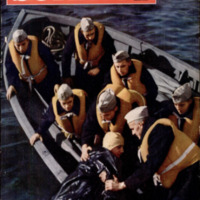 Popular Science Monthly, v. 142, n. 3, 1943
Popular Science Monthly, v. 142, n. 3, 1943

